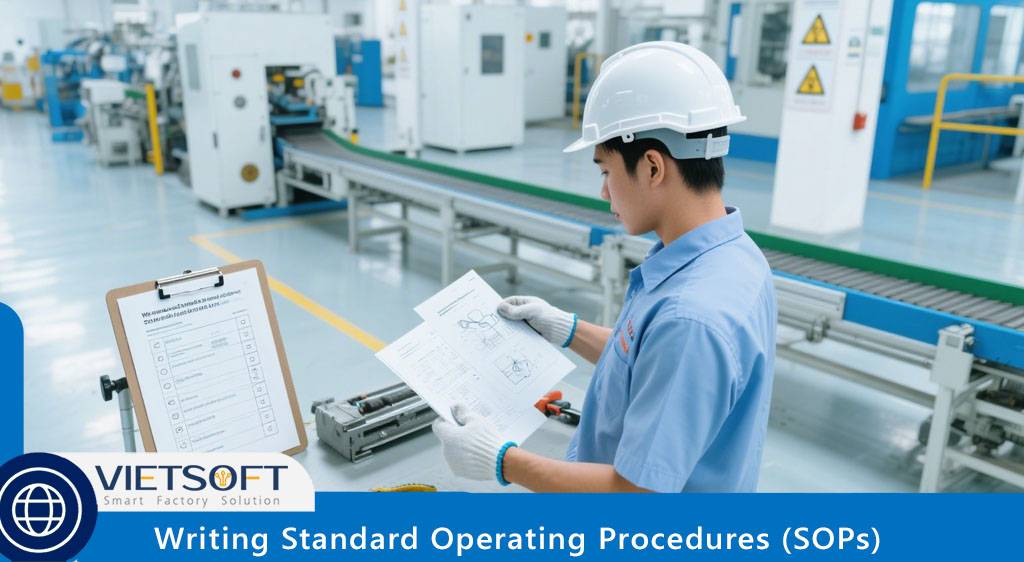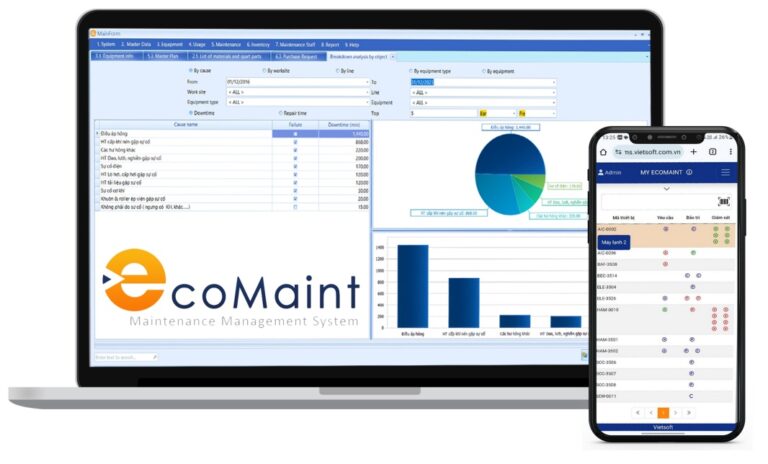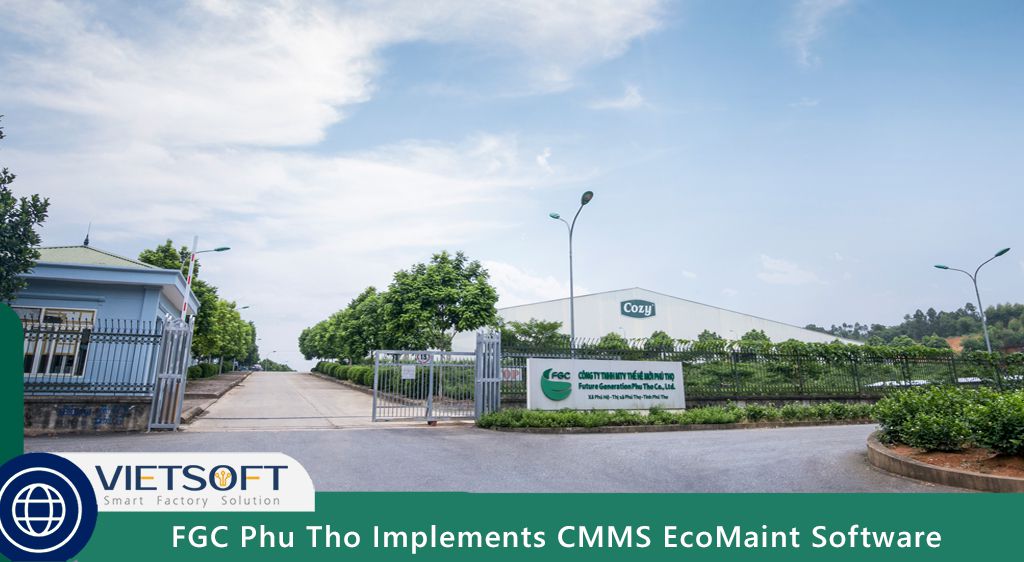
In today’s fast-paced industrial environment, ensuring operational efficiency while minimizing downtime is critical for businesses aiming to stay competitive. One of the most effective tools to achieve this is writing Standard Operating Procedures (SOPs). These detailed, step-by-step instructions standardize tasks, streamline processes, and reduce inefficiencies that lead to costly delays. This comprehensive guide explores the concept of SOPs, their role in reducing downtime, and a detailed approach to writing effective SOPs.
I. What Are Standard Operating Procedures (SOPs)?
Standard Operating Procedures (SOPs) are documented guidelines that outline the steps required to perform routine tasks consistently and efficiently. In industrial maintenance, SOPs serve as a roadmap for technicians, ensuring that equipment upkeep, repairs, and preventive maintenance are carried out uniformly, regardless of who performs the task. By writing Standard Operating Procedures, organizations can achieve consistent outcomes, reduce errors, and enhance safety while minimizing downtime caused by equipment failures or human error.
SOPs are particularly vital in industries like manufacturing, where downtime can cost thousands of dollars per hour. For instance, a poorly maintained conveyor belt or an improperly executed repair can halt production, leading to significant financial losses. SOPs address these challenges by providing clear instructions, fostering accountability, and ensuring compliance with industry standards.
II. Why SOPs Matter in Industrial Maintenance
SOPs play a pivotal role in maintenance operations by:
- Ensuring Consistency: Standardized procedures ensure that every technician follows the same steps, reducing variability in task execution.
- Reducing Downtime: By addressing common causes of equipment failure, SOPs help prevent unexpected breakdowns and delays.
- Enhancing Safety: Clear safety protocols within SOPs minimize workplace accidents, protecting both employees and equipment.
- Simplifying Training: SOPs provide a structured framework for onboarding new technicians, reducing training time and errors.
- Preserving Knowledge: Documented procedures capture institutional knowledge, ensuring continuity even when experienced staff leave.
In the context of Vietsoft’s CMMS EcoMaint, SOPs can be digitized and integrated into the system, allowing technicians to access real-time instructions, track task completion, and monitor equipment performance, further enhancing operational efficiency.
III. The Role of SOPs in Reducing Downtime
Downtime, whether planned or unplanned, is a significant challenge in industrial settings. Unplanned downtime, often caused by equipment failures, human errors, or inefficient processes, can disrupt production schedules and erode profits. Writing Standard Operating Procedures with a focus on eliminating waste— inspired by Taiichi Ohno’s Lean Manufacturing principles—can significantly reduce downtime. Ohno’s DOWNTIME acronym (Defects, Overproduction, Waiting, Not utilizing talent, Transportation, Inventory excess, Motion waste, Excess processing) provides a framework for identifying inefficiencies and addressing them through SOPs.
IV. Applying the DOWNTIME Framework to SOPs
· Defects: Defects, such as faulty equipment or substandard repairs, can lead to production halts. SOPs should include detailed quality assurance steps, such as routine inspections and calibration checks, to minimize defects. For example, an SOP for a pump maintenance task might specify torque settings for bolts to prevent leaks.
· Overproduction: Producing more than necessary ties up resources and increases wear on equipment. SOPs can include guidelines for demand-driven maintenance schedules to avoid unnecessary repairs or overstocking of spare parts.
· Waiting: Delays caused by unavailable tools, parts, or technicians can stall operations. SOPs should outline pre-task preparations, such as ensuring all required tools are available before starting a repair.
· Not Utilizing Talent: Underutilizing skilled technicians can lead to inefficiencies. SOPs can incorporate skill-based task assignments, ensuring that complex repairs are handled by qualified personnel.
· Transportation: Unnecessary movement of tools or parts wastes time. SOPs can optimize workflows by specifying tool storage locations or streamlining part delivery processes.
· Inventory Excess: Overstocked spare parts tie up capital and space. SOPs should include inventory checks to align stock levels with actual maintenance needs.
· Motion Waste: Excessive physical movements, such as walking between workstations, reduce efficiency. SOPs can redesign workflows to minimize unnecessary motion, such as organizing tools in a central location.
· Excess Processing: Redundant steps, like duplicate data entry, waste time. SOPs can streamline processes by integrating tasks with CMMS tools like EcoMaint, which automates data logging and work order tracking.
By addressing these waste categories, SOPs can transform maintenance operations, reducing downtime and boosting overall productivity.
V. How to Write Effective Standard Operating Procedures (SOPs)
Writing Standard Operating Procedures requires a structured approach to ensure clarity, usability, and effectiveness. Below is a step-by-step guide to creating SOPs that drive results in industrial maintenance, expanded with insights from my experience and aligned with Google’s 2025 SEO guidelines for depth, clarity, and user intent.
1. Step 1: Identify the Process to Standardize
Start by selecting a specific maintenance process that needs standardization. This could be anything from lubricating a motor to conducting a full equipment overhaul. Use tools like CMMS EcoMaint to analyze historical maintenance data and identify processes with frequent errors or downtime. For example, if data shows repeated failures in a conveyor system, prioritize creating an SOP for its maintenance.
Key Tip: Involve frontline technicians in this step to gain insights into real-world challenges and ensure the SOP addresses practical needs.
2. Step 2: Define Clear Objectives
Every SOP should have a clear purpose. Ask: What outcome does this SOP aim to achieve? For instance, an SOP for replacing a hydraulic filter might aim to reduce replacement time by 20% and prevent oil contamination. Objectives should be SMART (Specific, Measurable, Achievable, Relevant, Time-bound) to provide clear direction.
Example Objective: “This SOP ensures that hydraulic filter replacements are completed in under 30 minutes, reducing equipment downtime and maintaining system efficiency.”
3. Step 3: Document Step-by-Step Instructions
Write clear, concise instructions that any technician can follow, regardless of experience. Break the process into small, actionable steps and use imperative verbs (e.g., “Tighten the bolt to 50 Nm”). Avoid jargon and ambiguous terms like “occasionally” or “as needed.” Instead, provide precise instructions, such as “Check oil levels every 500 operating hours.”
Example:
- Step 1: Shut down the machine and lock out the power source.
- Step 2: Remove the filter housing using a 12 mm wrench.
- Step 3: Inspect the old filter for debris and log findings in CMMS EcoMaint.
- Step 4: Install the new filter, ensuring the O-ring is properly seated.
- Step 5: Restart the machine and check for leaks.
4. Step 4: Incorporate Visual Aids
Visuals like diagrams, flowcharts, or photos enhance understanding, especially for complex tasks. For instance, include a labeled diagram of a machine’s components or a flowchart for troubleshooting a motor failure. Ensure visuals are high-quality and optimized for web use.
5. Step 5: Embed Safety and Quality Measures
Safety is paramount in maintenance. SOPs should include specific safety protocols, such as wearing personal protective equipment (PPE) or locking out machinery before repairs. Quality measures, like torque specifications or calibration checks, ensure consistent outcomes. For example, an SOP for bearing replacement might specify: “Wear safety gloves and goggles; verify bearing alignment using a laser alignment tool.”
6. Step 6: Collaborate and Validate
Engage stakeholders—technicians, supervisors, and engineers—to review the SOP draft. Their feedback ensures accuracy and practicality. Use collaborative tools within CMMS EcoMaint to share drafts and collect input in real time. Validation ensures the SOP aligns with operational realities and industry standards.
7. Step 7: Implement and Train
Once finalized, roll out the SOP through training sessions. Use a mix of hands-on demonstrations, video tutorials, and written guides to cater to different learning styles. CMMS EcoMaint can store SOPs digitally, making them accessible on mobile devices for on-the-job reference. Track training completion to ensure all technicians are proficient.
8. Step 8: Monitor and Update Regularly
SOPs are not static; they must evolve with changing equipment, regulations, or processes. Schedule periodic reviews (e.g., every 6 months) to incorporate new insights or feedback. CMMS EcoMaint can trigger reminders for SOP updates based on equipment maintenance schedules or failure trends.
9. Step 9: Implement Document Control
Maintain version control to track SOP revisions and ensure technicians access the latest version. Include a header with the SOP title, document number, version, and effective date. For example:
- Title: Hydraulic Filter Replacement SOP
- Document Number: MNT-002
- Version: 1.2
- Effective Date: July 10, 2025
10. Step 10: Measure Effectiveness
Evaluate the SOP’s impact by tracking key performance indicators (KPIs) like downtime reduction, task completion time, or error rates. CM key performance indicators (KPIs) like downtime reduction, task completion time, or error rates. CMMS EcoMaint provides analytics to measure these metrics, helping you refine SOPs for continuous improvement.
Example KPI: “After implementing the SOP for conveyor belt maintenance, unplanned downtime decreased by 15% within three months.”
VI. Best Practices for Writing SOPs in 2025
To ensure Standard Operating Procedures (SOPs) are effective and user-friendly for maintenance teams, follow these best practices tailored for clarity and practicality:
- Use Active Voice: Write instructions in an active voice for directness and engagement. For example, “Replace the filter” is clearer than “The filter should be replaced.”
- Enhance Readability: Break instructions into short sentences, bullet points, or numbered lists to make SOPs easy to follow. This helps technicians quickly grasp key steps during high-pressure tasks.
- Integrate Relevant Terms Naturally: Use terminology familiar to maintenance professionals, such as “preventive maintenance” or “equipment calibration,” to ensure relevance without overwhelming the reader.
- Link to Related Processes: Reference related SOPs or resources within the document to provide context. For example, an SOP for pump maintenance might link to a troubleshooting guide for common pump failures.
- Ensure Mobile Compatibility: Format SOPs for mobile devices, as technicians often access instructions on smartphones or tablets while working on-site.
- Keep SOPs Current: Regularly review and update SOPs to reflect changes in equipment, or regulations, ensuring they remain accurate and practical for daily use.
VII. Integrating CMMS EcoMaint for Enhanced SOP Management
To maximize the impact of SOPs, consider integrating them with Vietsoft’s CMMS EcoMaint, a powerful maintenance management solution designed to streamline operations. EcoMaint allows you to:
- Digitize SOPs: Store and access SOPs on mobile devices, ensuring technicians have real-time guidance.
- Automate Work Orders: Link SOPs to recurring maintenance tasks, reducing manual oversight.
- Track Performance: Use built-in analytics to monitor SOP adherence and downtime trends.
- Enhance Collaboration: Share SOP drafts with teams for feedback and validation.
By embedding SOPs within EcoMaint, you create a seamless workflow where technicians can follow procedures, log tasks, and report issues in one platform.
Discover the CMMS EcoMaint solution here.
Contact us for consultation via hotline: 0986778578 or email: sales@vietsoft.com.vn.
VIII. Real-World Example: SOP for Conveyor Belt Maintenance
To illustrate, here’s a sample SOP for maintaining a conveyor belt, formatted for clarity and usability:
Title: Conveyor Belt Maintenance SOP
Document Number: MNT-003
Version: 1.0
Effective Date: July 15, 2025
Objective: To ensure conveyor belts operate smoothly, reducing unplanned downtime by 10% through consistent maintenance.
Steps:
1. Shut down the conveyor system and lock out the power source to prevent accidental startup.
2. Inspect the belt for wear, tears, or misalignment; log findings in CMMS EcoMaint.
3. Clean the belt surface using a non-abrasive cleaner to remove debris.
4. Check pulley alignment with a laser tool, adjusting if deviation exceeds 0.5 mm.
5. Lubricate bearings with grease (e.g., Mobil SHC 220) every 1000 operating hours.
6. Tighten bolts to 40 Nm using a torque wrench.
7. Restart the system and monitor for vibrations or unusual noises for 5 minutes.
8. Record completion in CMMS EcoMaint, including any issues detected.
Safety Measures:
- Wear safety goggles and gloves during maintenance.
- Ensure lockout/tagout procedures are followed.
Visual Aid: Include a diagram showing pulley alignment points and bearing locations.
This SOP, when integrated with CMMS EcoMaint, ensures technicians follow standardized steps, track maintenance history, and receive automated reminders for future tasks.
IX. Common Challenges in Writing SOPs and How to Overcome Them
· Lack of Clarity: Vague instructions lead to errors. Use precise language and test SOPs with technicians to ensure clarity.
· Resistance to Change: Technicians may resist new procedures. Involve them in the SOP creation process to foster buy-in.
· Outdated SOPs: Procedures can become obsolete. Use CMMS EcoMaint to schedule regular reviews and updates.
· Overcomplication: Overly detailed SOPs can overwhelm users. Focus on essential steps and use visuals to simplify complex tasks.
X. Conclusion
Writing Standard Operating Procedures (SOPs) is a cornerstone of effective maintenance management, enabling organizations to reduce downtime, enhance safety, and improve efficiency. By following a structured process—identifying key tasks, defining objectives, documenting clear steps, and leveraging tools like CMMS EcoMaint—businesses can create SOPs that deliver measurable results. The DOWNTIME framework provides a powerful lens for eliminating waste, while best practices like active voice, visual aids, and regular updates ensure SOPs remain relevant and user-friendly.
For maintenance teams looking to take their operations to the next level, integrating SOPs with Vietsoft’s CMMS EcoMaint offers a game-changing solution. From digitizing procedures to automating work orders, EcoMaint empowers teams to work smarter, not harder.




